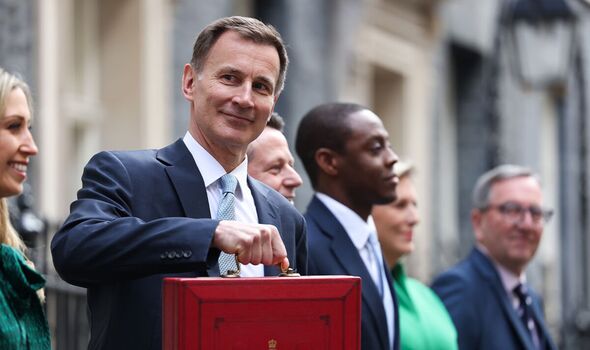
Capital Gains Tax: What it is, when you have to pay and new rules after the Budget (Image: GETTY)
Capital Gains Tax (CGT) is a vital part of taxation in the UK that impacts people who sell assets, such as property, stocks, or businesses at a profit.
Personal allowances for this tax began shrinking last April, and this trend is expected to persist into the next fiscal year, drawing more individuals into its scope.
According to the latest HMRC figures, Capital Gains Tax receipts surged to £11.4 billion in January following last year’s reduction in allowances.
However, Chancellor Jeremy Hunt announced the rate of taxation on property will change from April 6 in a move aimed at boosting the troubled housing market. Subsequently, people will be able to make a saving.
Here’s a rundown of everything you need to know about Capital Gains Tax now – and what you can expect after the Spring Budget.

Capital Gains Tax is changing for people selling their properties (Image: GETTY)
What is Capital Gains Tax?
Capital gains tax (CGT) is a tax levied on the profit people make when selling an asset.
While it’s commonly linked with property sales, CGT also applies to many other types of sales, such as stocks and businesses.
The “gain” is the amount that is taxed, not the amount of money a person receives. For example, someone who bought a painting for £5,000 and sold it later for £25,000, would have made a gain of £20,000 (£25,000 minus £5,000).
When do you have to pay Capital Gains Tax?
CGT typically applies when a person sells or disposes of an asset that has increased in value since they purchased it.
This can include selling a second home, shares, or even valuable personal possessions.
However, not all assets are subject to CGT. For instance, a person’s primary residence is usually exempt from CGT under the Principal Private Residence (PPR) relief scheme, provided certain conditions are met.
Capital Gains Tax allowances
People only have to pay Capital Gains Tax on the overall gains above their tax-free allowance, which is called the Annual Exempt Amount.
Currently, the Capital Gains tax-free allowance is:
- £6,000 (down from £12,300 in 2022/23)
- £3,000 for trusts (down from £6,150 in 2022/23).
These rates are set to halve again on April 6, bringing the annual allowance down to £3,000.
Capital Gains Tax rates
People pay a different tax rate on gains from residential property than they do on other assets. This rate changes based on a person’s income tax band.
The rate for basic rate taxpayers depends on the size of their gain, their taxable income and whether their gain is from residential property or other assets. The rate for this band ranges between 10 percent (18 percent on properties) and 20 percent (28 percent on properties).
People who are higher or additional rate taxpayers pay 28 percent on their gains from residential property. Meanwhile, a 20 percent charge is applied gains from other chargeable assets.
However, some of these rules will change in the next tax year.
What are the new Capital Gains Tax rules after Spring Budget?
In efforts to “support the housing market”, Chancellor Jeremy Hunt announced the higher rate of Capital Gains Tax on property will be cut from 28 percent to 24 percent from April 2024.
The lower rate will remain at 18 percent for any gains that fall within an individual’s basic rate band. This measure aims to “encourage” landlords and second homeowners to sell their properties, thereby increasing availability for a diverse range of buyers, including first-time buyers.
Additionally, it is anticipated to generate increased revenue over the forecast period.
Private Residence Relief will remain in place, meaning the vast majority of residential property disposals will pay no CGT.
Shaun Moore, tax and financial planning expert at Quilter, described the move as “welcome relief” for those who own a second home or an investment property and plan to sell it in the next year.
Mr Moore said: “This means a higher-rate taxpayer making a gain of £20,000 on their second home will pay £4,080 in CGT, after deducting the £3,000 CGT allowance. This is £680 less than what they would have paid under the previous regime, which would have charged them £4,760.”
However, he noted: “The new rate does not apply to the entire gain if it straddles the basic rate and higher rate bands. For example, someone who earns £45,000 and makes a gain of £20,000 on their second home will pay £3,763 in CGT, after deducting the £3,000 CGT allowance.
“This is because they will pay 18 percent on the portion of the gain that falls within the basic rate band (£5,270) and 24 percent on the portion of the gain that falls within the higher rate band (£11,730).”
He added: “The Government hopes that this measure will stimulate the property market, however with the abolition of the holiday letting regime, for some, it will be a case of robbing Peter to pay Paul.”
How to mitigate Capital Gains Tax
There are many ways to mitigate a heft CGT bill, such as using up allowances and investing funds in ISAs.
Laura Suter, director of personal finance at AJ Bell, said: “If you have investments outside a tax wrapper, the savviest move is to transfer that money into an ISA, or into a pension if you can afford to tuck it away for longer.
Ms Suter continued: “For those sitting on large capital gains you can sell assets to realise a gain up to your remaining tax-free allowance and then buy it back within your ISA, which means you’ll make use of the tax-free allowance and protect any future gains from the taxman.
“You can use your platform’s Bed and ISA service, just make sure you check the deadline, which is usually a few working days before the tax year-end.”
People can also transfer assets to a spouse, as these are exempt from the tax.
Ms Suter explained: “This means that if your spouse hasn’t used up their tax-free allowance this year and has some ISA allowance remaining, you can make use of those tax breaks. You just need to make sure you keep a note of the original cost of the asset, as that’s what will be used when your partner comes to sell it.
“If your spouse is in the basic rate income tax bracket but you’re a higher or additional rate taxpayer, there’s a double benefit, as they will pay capital gains tax at a lower rate.”
Additionally, people could use pension contributions to drop an income tax band. Ms Suter said: “This means that the rate of capital gains tax you pay could be lower if it means you are no longer a higher-rate taxpayer.
“This is a particularly handy trick if you’ve only just tipped over into the next tax band, meaning a small pension contribution would bring you under the threshold.”



